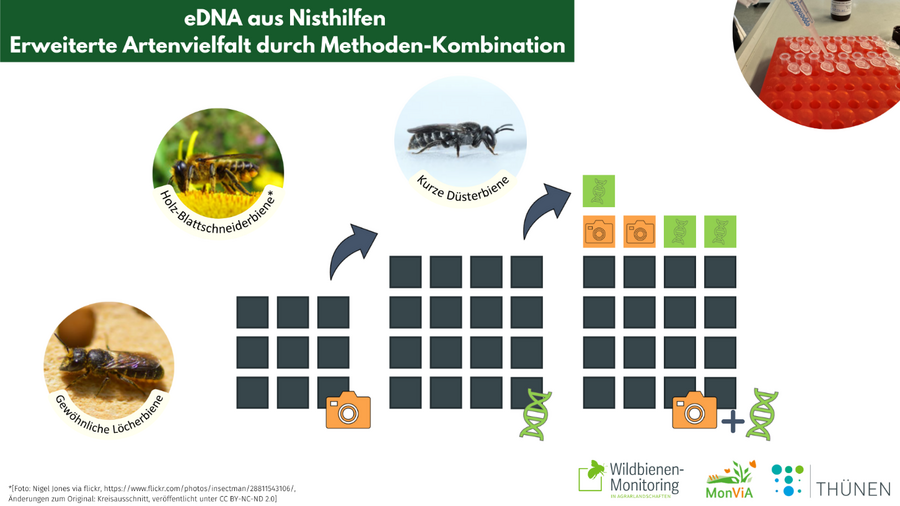
Since 2021 more than 350 volunteers have been involved in monitoring cavity-nesting wild bees in agricultural landscapes. They maintain nesting aids and photographically document the occupancy. These photos are analyzed by researchers at the Thünen Institute of Biodiversity to identify the wild bee species. However, this is often only possible at the genus level, making precise species identification impossible.
At the end of 2023, after adult hatching, volunteers sampled the nesting aids for the first time for eDNA (environmental DNA) analysis. These samples were sent to the Thünen Institute and analyzed in the DNA laboratory. Initial results are now available and were presented in an online webinar.
eDNA analysis can increase the reported biodiversity
eDNA analysis can expand the results obtained from photographs and resolve species complexes. For example, in the Leafcutter bee genus, it was possible to more precisely determine which species were present in the nesting aids. Among other species, the endangered Wood-carving Leafcutter Bee (Megachile ligniseca) was detected.
DNA analysis also identified cuckoo bees such as the Little Dark Bee (Stelis breviuscula), which had not previously been identified at species level based on photographs.
A total of nine species groups were recorded using photographs, of which 16 species were detected using eDNA analysis, providing species-level identifications. In addition, two species were observed only using photographs and three species were recorded only using eDNA analysis.
More than just bee species richness
The eDNA analysis also provides important additional data on the species community within the nesting aids. It allows for the assessment of intraspecific diversity, the detection of antagonists and cavity-nesting wasps, and the analysis of plant residues. This allows for the investigation of the foraging behavior of wild bees in relation to the surrounding agricultural landscape.
Photographic recording remains important
However, eDNA analysis cannot completely replace photographic recording of wild bees. Some rare species, such as the Banded Mud Bee (Megachile ericetorum) and the Northern Small Wool Carder Bee (Pseudoanthidium nanum), have so far been detected exclusively through photographic analysis. Overall, only a combination of the two methods provides a comprehensive picture within the nesting aids. The wild bee monitoring program will therefore continue utilizing both methods in future.
What is eDNA?
Organisms leave behind DNA traces through their interactions with the environment, so-called environmental DNA (eDNA). These traces can be used for minimally invasive biodiversity assessment. In the case of nesting aids, eDNA can be present in the form of feces and pollen residues and is scraped out of the nesting tubes after the bees and wasps hatch. The DNA contained therein is processed in the laboratory and used for DNA-based species assessment
United for wild bees
Researchers from the Wild Bee Monitoring in Agricultural Landscapes and Molecular Ecology in Agricultural Landscapes working groups have been conducting wild bee monitoring within the MonViA project since 2021. The goal is to record the status and population trends of wild bees in agricultural landscapes. The monitoring program is continuously being developed further in collaboration with numerous volunteers.
More information about this exciting project can be found here.
Contact: Thünen-Institut für Biodiversität, wildbienen(at)thuenen(dot)de, phone: +49 (0) 531 2570 2200